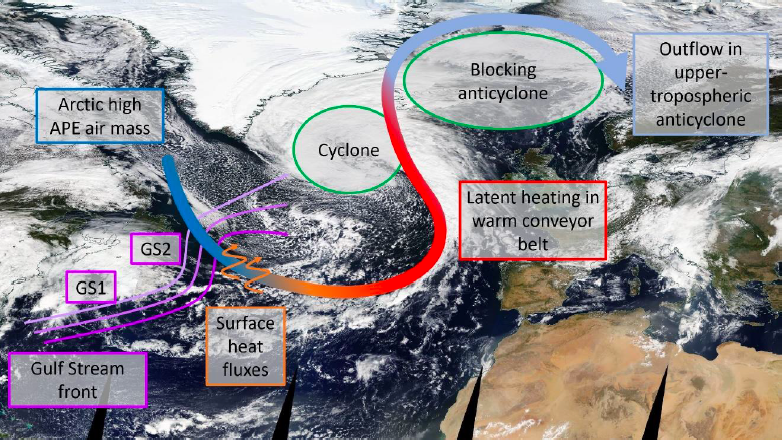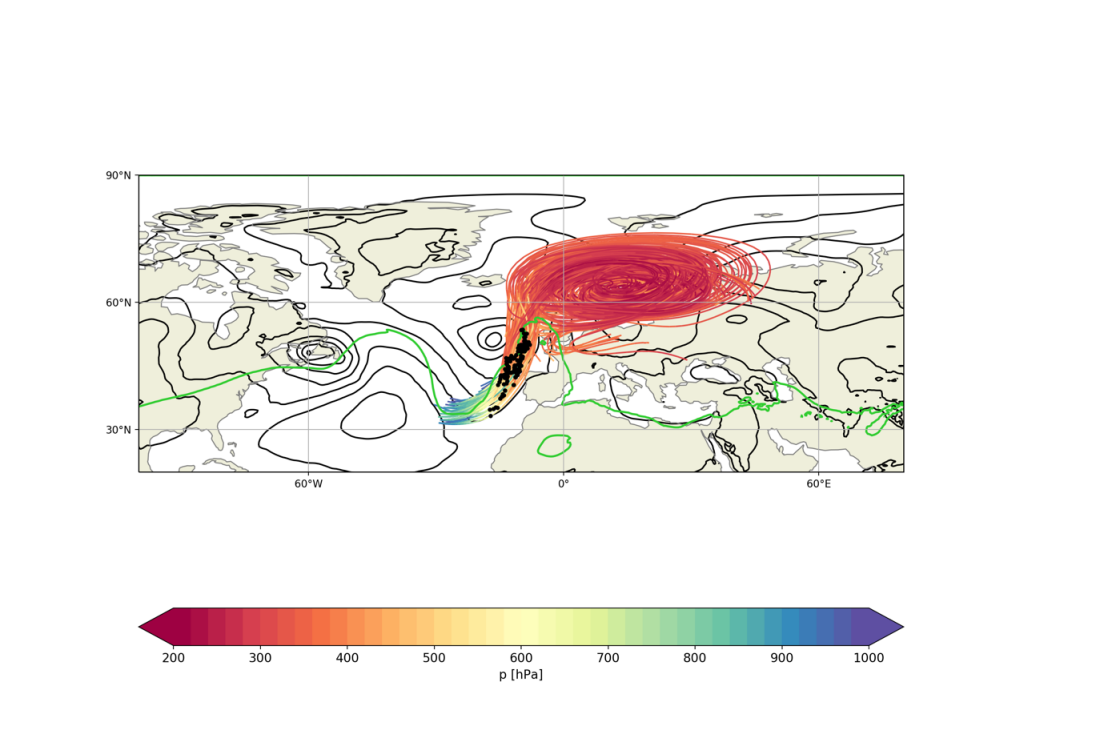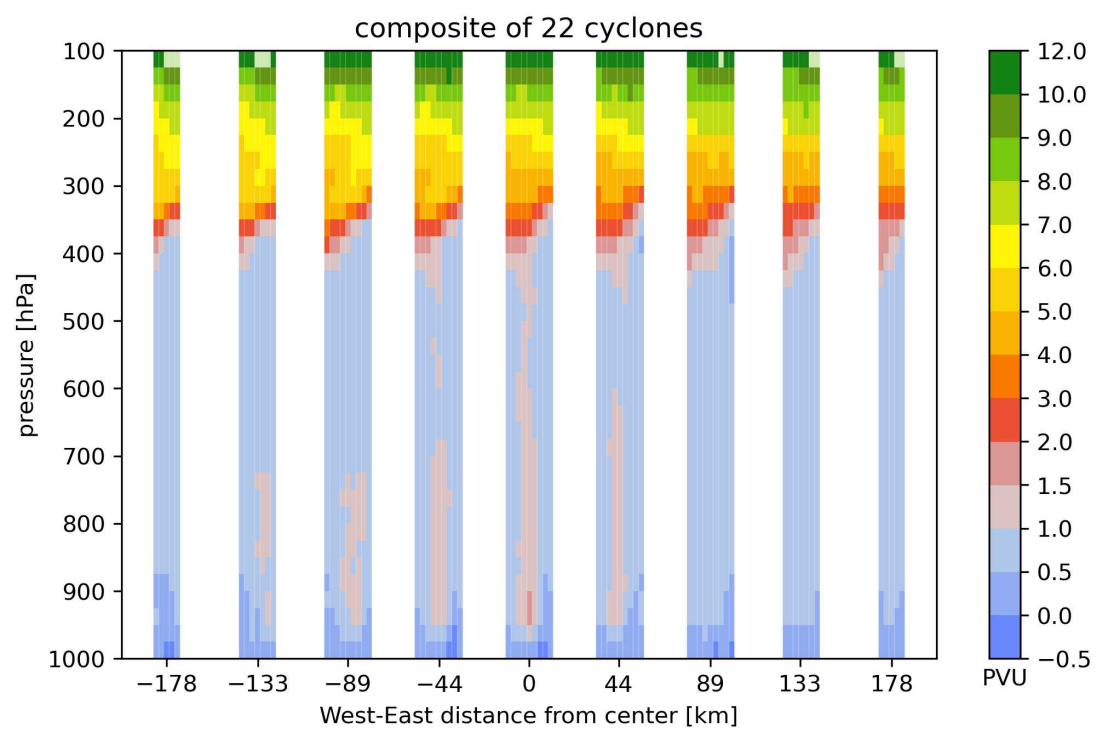Weather system dynamics
Weather in the extratropics is strongly determined by the evolution of distinct synoptic-scale weather systems, including cyclones, fronts, blocking anticyclones, and upper-level PV streamers and cutoffs. It is a primary aim of our research group to investigate the climatological frequency of these systems, their underlying dynamical processes, and the capability of today’s NWP models to correctly predict their genesis, track and intensity. Our research during the recent years revealed the key importance of latent heating in clouds, in particular in warm conveyor belts, for the evolution of extratropical weather systems. As shown in idealized baroclinic wave simulations, detailed case studies with NWP models, and climatological analyses using reanalysis data, the latent heating in conveyor belts can at the same time influence the evolution of the cyclone itself (via diabatic PV production at low levels) and of the downstream upper-level ridge and Rossby wave evolution (via the production of significant negative PV anomalies at upper levels). In addition to influencing the dynamics of weather systems, the conveyor belts also contribute essentially to precipitation extremes in many parts of the extratropics.
The group has particitpated in the external page NAWDEX field experiment during autumn 2016, where the German HALO and Falcon aircrafts investigated the linkage between cloud diabatic processes and the upper-level Rossby wave evolution.
The senior scientists working in this research area and their core themes are Maxi Boettcher (diabatic Rossby waves and the analysis of field experiment data), Hanna Joos (detailed analysis of cloud microphysics and radiation and their interaction with weather system dynamics) and Lukas Papritz (linking polar meteorolgy with extratropical storm track dynamics).
Current PhD projects are conducted in this research area are outlined below.
Investigating the jet-storm-track relationship in the present and future climate

Nora Zilibotti
The midlatitude weather in winter is shaped by extratropical storm tracks. In general the monthly mean strength of the storm tracks scales with mean baroclinicity and jet strength throughout the seasons. However, some exceptions, such as the North Pacific midwinter suppression, challenge this linear relationship. Given the projected changes in a warmer atmosphere, we expect that understanding non-linearities such as the midwinter suppression, as well as the effect of diabatic processes on storm track activity might play an important role for improving our understanding of regional climate change. Understanding the role of diabatic processes is a particular challenge because their effect is only partially resolved in weather and climate models. This doctoral thesis thus aims to investigate how the storm tracks depend on jet characteristics on daily to monthly time scales in reanalysis data, idealised simulations, and climate model data. In particular, measures of storm track activity based on spectral decomposition will be combined with feature-based studies. The former involves computing high-frequency components of the flow, providing measures such as the eddy kinetic energy, and understanding how processes contributing to them vary with jet strength, warming, and model resolution. The latter focuses on the evolution and structure of cyclones, troughs, and ridges, including their effect on the spectral-based wave activity measures. Both methods will be used to analyse the storm tracks for different strengths of background jets in a present and future climate and for different model resolutions.
Supervised by Heini Wernli and Sebastian Schemm.
The interplay between BCARs and the large-scale atmospheric circulation

Franziska Schnyder
During winter intense radiative cooling leads to the formation of extremely cold continental air masses at high latitudes and induces anticyclogenesis over the vast land masses of Siberia and Canada. From a climatological perspective, these air masses feature the lowest surface temperatures and highest sea level pressures observed in the Northern Hemisphere. Cold air outbreaks (CAOs) originating from such extremely cold and dry (in terms of absolute humidity) air masses may result in record breaking cold spells in nearby, densely populated regions as well as very strong air-sea interaction over the ocean. To date, a systematic description of these very cold anticyclones and an assessment of their role in the large-scale atmospheric circulation is missing. Thus, we introduce the concept of a Boreal Cold Air Reservoir (BCAR), a framework which combines the thermodynamic and dynamic components of these cold anticyclones into a single weather system, fundamentally driven by diabatic cooling.
In the scope of this PhD project the impact of the BCARs on the large-scale atmospheric circulation is investigated in detail within both reanalysis data and simulations from numerical weather models. As BCARs are located upstream of the North Atlantic and North Pacific, the focus of this project lies on their influence on marine CAOs along the western boundary currents of these basins and the downstream storm tracks. The amount of BCAR air contributing to CAOs will be investigated to determine whether a different BCAR contribution results in systematic differences in the air-sea interaction in CAO regions. Applying a Lagrangian perspective, we evaluate if and how often BCAR air participates in storm track processes, such as warm conveyor belts or the moisture-handover mechanism, and how this affects storm track dynamics. Simulations of few representative case studies of CAOs will be performed using the IFS with modified radiation physics in the source region of diabatic cooling to support the findings from the reanalysis data.
Supervised by Jacopo Riboldi and Heini Wernli
GULFimpact: The role of coherent air streams in shaping the Gulf Stream’s impact on the large-scale extratropical circulation

Marc Federer
Extratropical cyclones are key in shaping mid-latitude weather and are the dominant driver of wintertime wind and precipitation hazards in the North Atlantic region. The growth mechanisms of extratropical cyclones have been explored extensively in past research, which lead to established theories of cyclone intensification. Nevertheless, the understanding of how air-sea heat exchange and latent heat release associated with extratropical cyclones are conveyed to the large-scale circulation on synoptic spatio-temporal scales remains limited.
As part of the GULFimpact project, we explore the interaction of North Atlantic extratropical cyclones with the Gulf Stream and the large-scale circulation from an energetics perspective. To this end, we apply a novel diagnostic of available potential energy to the ERA5 reanalysis dataset in the North Atlantic and analyze the life cycles of weather regimes. The energetics perspective will also be utilized to gain insights into the maintenance of baroclinicity along the storm track during periods of serial clustering of extratropical cyclones, for which the predator-prey behavior of extratropical cyclones and baroclinicity is not well understood. This analysis will yield a refined mechanistic understanding of synoptic variability in the North Atlantic storm track, which is paramount for improving the representation of extratropical large-scale flow variability in state-of-the-art numerical weather prediction models.
Supervised by Lukas Papritz, Michael Sprenger and Heini Wernli

Warm Conveyor Belts in a warming climate
Katharina Heitmann
A large part of precipitation in the mid-latitudes is caused by airstreams called Warm Conveyor Belts (WCBs). Here, large quantities of moist air from lower levels ascend rapidly to higher altitudes, thus inducing a wide range of diabatic processes such as condensation and rain formation. Previous models struggled to reproduce WCBs correctly, as the narrow and rapid ascent requires a relatively high temporal and spatial resolution. Fortunately, the European Centre for Medium-Range Weather Forecast (external page ECMWF) recently published a new dataset (ERA-5) which provides global and high-resolution data (1979-present).Thereby, we are now able to analyze WCBs in an unprecedented way.
This PhD project aims to analyze the relationship between the characteristics (intensity, curvature, moisture content, …) and impacts (precipitation, PV anomalies, …) of WCBs as well as their spatial and temporal distribution based on ERA-5. These findings will be used later on to compare the representation of WCBs in weather models (ERA-5) and climate models (CESM) in present-day and future climate.
Supervised by Hanna Joos, Michael Sprenger, Hanin Binder and Heini Wernli
Investigation of the origin of positive potential vorticity anomalies inside Mediterranean cyclones

Mediterranean cyclones are extra-tropical cyclones, typically of smaller size and weaker intensity than other cyclones that develop over the open Oceans. Nevertheless, Mediterranean cyclones are still capable of attaining high intensities, even comparable to the ones of tropical cyclones, and thus to cause large socio-economic impacts in the densely populated coasts of the region.
Due to the surrounding mountains and its latitudinal location between the tropics and the storm tracks, the Mediterranean basin provides a unique region for the formation of cyclones (cyclogenesis). Mediterranean cyclonesis is typically triggered by barcolinic instability, related to the intrusion of stratospheric air as a direct result of Rossby wave breaking. After cyclogenesis, a large variety of processes are involved in the cyclones' development, contributing to the low-level potential vorticity (PV) budget of the systems. The origin of these positive low-level PV anomalies is yet to be understood.
More precisely, we aim to determine whether PV contributions to cyclone development take place within the cyclone itself, or they are produced in remote areas (e.g. due to mountains-air flow interactions). To tackle this question, our analysis is based on a Lagrangian approach, where backward trajectories are combined with cyclone tracks to separate the local change of PV that takes place within a cyclonic system from the changes that take place remotely. With this we further want to uncover if there are process-wise differences between Mediterranean and extra-tropical cyclones that develop in the mid-latitude storm tracks.
Supervised by Emmanouil Flaounas and Heini Wernli